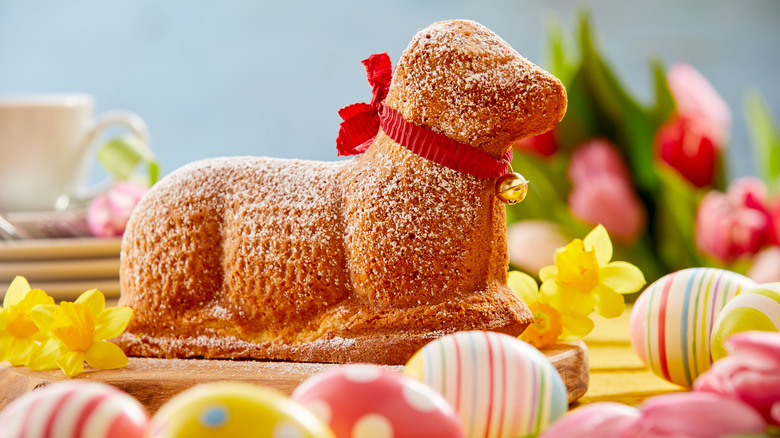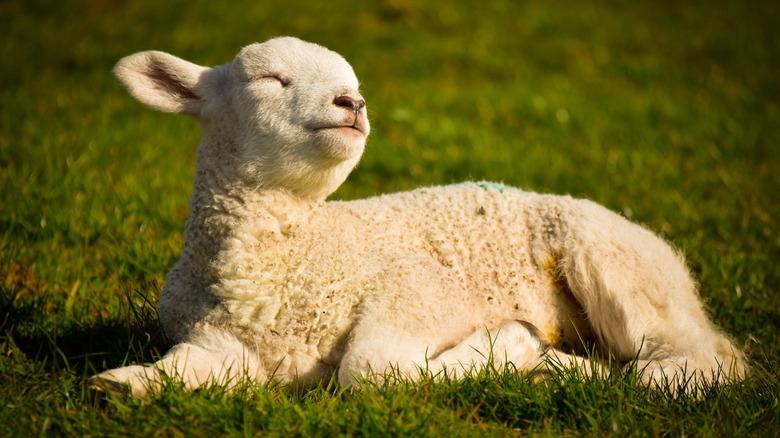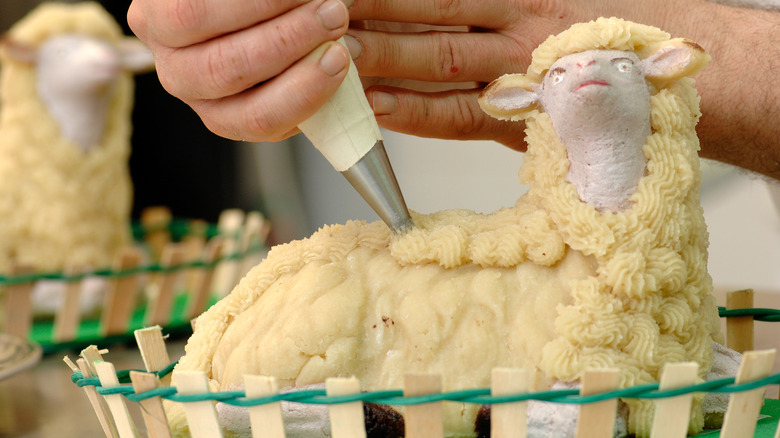The Polish Lamb Cake You Should Consider For Your Easter Celebration
Easter is a significant religious holiday for many people and families across the globe. To celebrate, different cultures implement an array of foods and symbols on their tables, which are typically surrounded by families who gather to feast. Hot cross buns are an English tradition that represent good luck. In Greece, tsoureki, a braided loaf of sweet bread studded with bright red dyed eggs, is an Easter staple. In Lithuania, families enjoy cepelinai, or potato and meat dumplings, while many countries (including America) feature roast lamb as the main course.
Easter is also marked by eggs, Easter bunnies, lily's, pastel colors, and crosses, which all symbolize the springtime holiday. If you're looking for something new and different to add to your tried and true favorites, you can take a cue from Poland, which has plenty of traditional Easter dishes of its own. White borscht soup, red cabbage, and a beautiful, fruity tart called mazurek królewski are all enjoyed during the special time of year, as is a darling little cake shaped like one of Easter's most prominent symbols: the lamb.
A Polish tradition
The lamb is a symbol that holds notable esteem in Christianity with the animal representing Jesus Christ as the sacrificial "Lamb of God," who is said to have been resurrected on what is now called Easter Sunday. The presence of lambs on Easter, therefore, is prominent, not just in the form of roast lamb for dinner, but as a shape for cakes, as seen in Easter lamb cake, also known as beránek (also spelled baranek). It is said that Easter lamb cakes started in Germany and then passed to Poland and other European countries before being brought to America by immigrants. Including the cake on the Easter feasting table is popular in Poland, as is butter, chocolate, and candies, all carved, formed, and shaped like the young sheep.
A beránek is a cake resembling a lamb that is lying on its haunches. The mold in which it's made usually depicts the lamb with its head turned, so as to look to its left or right. It can be decorated simply, with a dusting of powdered sugar, or more elaborately with frosting and candies, but both forms often include a red ribbon around its neck, symbolizing the blood of Jesus Christ. Even those who don't practice a specific religion are accustomed to lamb shapes and often include them in their own Easter celebrations because lambs represent purity, innocence, and sweetness. The sweet cake is a delight to decorate, look at, and of course eat.
Making a Polish lamb cake
Traditionally, Polish lamb cakes are made in molded metal baking pans from a sturdy cake batter like pound cake, which is denser than most cakes and has a smaller chance of sinking when it's taken out of the oven. The texture of the cake is particularly important if you are decorating with frosting; Lighter cakes could tear and fall apart easier than pound cake. The mold comes with two halves, but it's only the half with the lamb's face that gets filled with batter. Once the batter is poured in, the back portion is placed on top and, as the cake rises, the back part of the lamb puffs up and is molded. Once un-molded and cooled, you can decorate the cake as desired.
A lamb mold is certainly a convenient tool for this baking project, but it's not altogether necessary. It's actually possible to make an adorable beránek with three standard cake pans. Two of the cakes will go into sculpting the lamb's body while the third is made into a sort of cake pop mixture. The texture of the mixture is perfect for molding the feet, head, and ears of the animal. Some frosting will both glue the pieces to the body and decorate the sweet little dessert.
Lamb cakes can be for everyone on Easter, whether Polish, or Christian, or completely otherwise. One thing is for certain: It will add to the joy of the special day.


